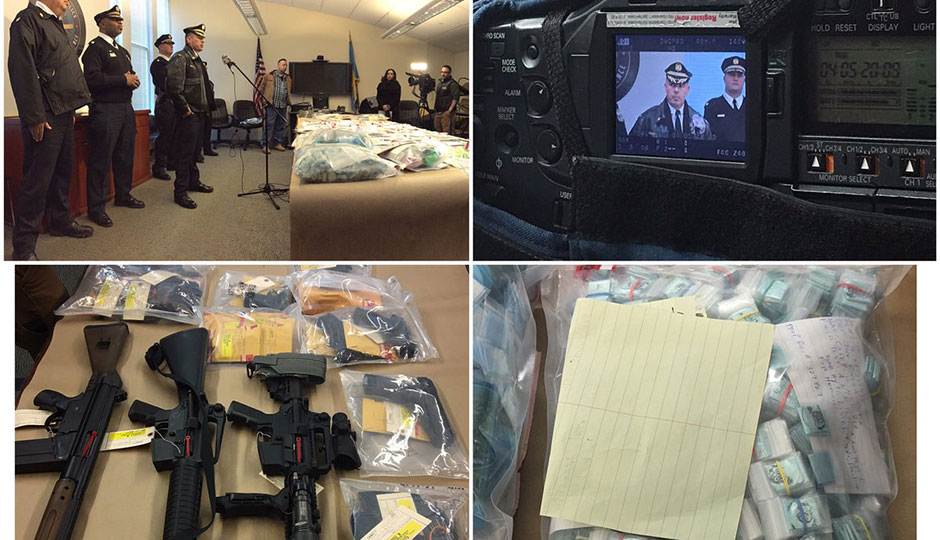How Drug Busts in Kensington Could Make Things Even Worse

Photos via @PhillyPolice
The police laid the drugs, the money, and the guns on the table. The cameras rolled. And another victory in the drug war was declared.
After a string of at least 35 polydrug overdose deaths earlier this month, the cops moved in. From December 14th to 16th, Philadelphia police made 176 arrests in the East Detective Division, which includes Feltonville, Hunting Park, Juniata, Kensington, Port Richmond, and other parts of North Philly. At a press conference on the 20th, they showed off 21 guns, almost $50,000 in cash, and what the department said was $200,000 worth of heroin and other drugs.
“We have great community groups that are kind of trapped in those heroin markets,” police Captain Mike Cram told reporters. “And when they see a big operation like this, it gives them hope. And that’s what they need — they need hope down there.” Chief Inspector Dan MacDonald said the drug busts were conducted in part to “[develop] intelligence information that is leading us to larger organizations that we can target.” He added that he believes “with enough resources and energy,” police can drive the drug trade out of Kensington.
But police have been doing drug raids in Kensington and other parts of North Philly for decades now, and the drug trade has not been pushed away. Drug prohibition has not depleted drug supply. And, according to research, the drug sweep last week could make things worse.
6 ABC wrote on its homepage that “the streets in one Philadelphia neighborhood are a little safer today.” That may be true right now, but evidence shows it won’t be the case for long. In a 2011 edition of the International Journal of Drug Policy, five researchers conducted a meta-analysis of 15 studies of illegal drug market–related violence. Fourteen of those studies reported an increase in violence in the vicinity of markets as drug enforcement intensified.
“Our findings suggest that increasing drug-law enforcement is unlikely to reduce drug-market violence,” the researchers wrote. “Instead, the existing evidence base suggests that gun violence and high homicide rates may be an inevitable consequence of drug prohibition and that disrupting drug markets can paradoxically increase violence.”
Many of the recent overdoses have been linked to fentanyl, a synthetic opioid that’s estimated to be 50 to 100 times more powerful than morphine. According to Leo Beletsky, an associate professor of Law and Health Sciences who got his law degree at Temple, drug enforcement is likely what led to the fentanyl crisis.
“Disrupting black markets [for drugs] with enforcement in the long term doesn’t do much good,” he tells Philadelphia magazine. “It’s basically a natural market response to disruption and to pressure. The more you do interdiction, the more you do busts, the more penalties you pile on, it really drives the market toward more potent forms of drugs. Trafficking fentanyl is more profitable than tracking heroin. … The idea that you can use enforcement to ultimately curb supply of something there’s a demand for goes against the fundamental rules of market economics.”
Philly social worker/writer Jeff Deeney recently reported that Kensington drug enforcement has driven users away from drug corners like Kensington and Somerset and toward dealers off the beaten path. “Users are going to seek less popular sets that draw less police attention in order to find something to use,” Deeney wrote in a series of tweets earlier this month. “And there’s a reason that those sets have no buyers. Frankly, users don’t want what they’re moving. And a lot of users don’t want synthetics if they can avoid using them, because for a number of reasons heroin is preferable to fentanyl and other analogs. So basically the narc squad … by shutting down literally every decent corner in Kensington created a big funnel diverting users to the set selling the most toxic product.”
There’s no doubt the cops are right: The raids in Kensington do give local residents “hope.” But it’s misplaced hope. Fox 29 Dave Schratwieser tweeted that “police admit it will take a week before new dealers take over these corners.” A week.
One-hundred seventy-six arrests over a three-day period, for at best a weeklong slowdown of drug sales in Kensington — and a likely uptick in violence and drug overdoses, plus more people thrown into our overcrowded prison system. There are better ways even under our current prohibitionist system: Low-arrest drug crackdowns, for example, have been shown to work better than general narc tactics.
But as long as we respond to the overdose crisis in the same way we’ve always done — more enforcement, tougher penalties, even homicide charges for drug sellers — the problem will not go away.
“I don’t blame police for trying to get dealers,” Beletsky says. “They have a very limited toolkit with which to work. … Attacking the supply chain, putting the faces of dealers online, and doing all kinds of enforcement helps the police and it helps the politicians create the semblance of doing something, but from a research and historical perspective it’s not something that can address drug-related harms. If anything, it exacerbates the harm.”